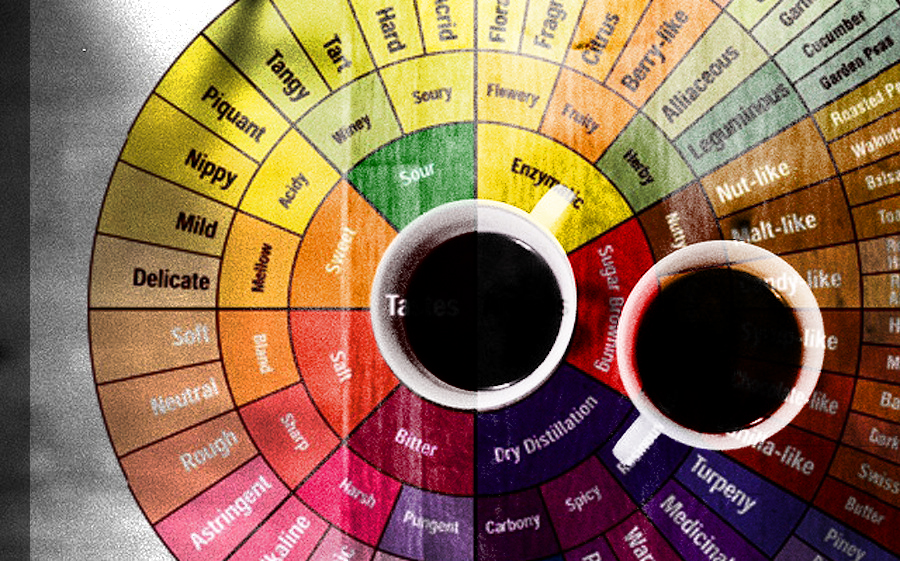Why is my coffee astringent? Huh? Coffee is also divided into "good" astringent, "bad" astringent?
Professional coffee knowledge exchange more coffee bean information please follow the coffee workshop (Wechat official account cafe_style)
I believe that when you buy coffee beans, the "taste description" written on the label will also be one of the reasons why you decide whether or not to buy coffee beans.
But I don't know if you have ever encountered such a situation: obviously the taste description says "smooth …" Caramel flavor, but the taste is bitter accounted for 80%!
What went wrong?

Why doesn't my coffee have a silky taste?
What is "astringent"? Although "astringent taste" is a feeling derived from oral taste, it is different from ups and downs. It is not a taste, but a sense of touch. Strictly speaking, it should be called "astringency". It is the reaction between polyphenols in food and saliva proteins in the mouth, creating a sense of roughness and discomfort. Astringent polyphenols exist in a variety of fruits, tea, red wine, chocolate, coffee, such as chlorogenic acid, tannin, catechin and so on.

Astringency is also divided into "good astringency" and "bad astringency"?
The dryness of coffee is very similar to the feeling in the mouth when eating apples and bananas, but high-quality coffee will never make you feel dry after drinking it. Therefore, the purpose of cup testing of coffee is to judge the flavor and baking quality of coffee. Negative astringency will expose the defects of coffee, and high-quality astringency is a symbol of coffee quality.
The "bad astringent taste" is lasting. The astringent taste produced in the process of coffee planting or processing is difficult to reverse, for example, the coffee fruit has been picked before it is ripe enough, improper roasting or uneven roasting also brings bad astringent taste.
"good astringency" is short-lived. Even carefully picked and selected coffee beans will have a certain astringent taste after processing, and the astringent taste will usually disappear after 3 to 4 months, so when tasting these new season coffee beans, astringent taste is the evidence of fresh coffee beans. The right amount of astringency can enrich the hierarchical sense of coffee and make the taste of coffee stay longer. Experienced coffee tasters can judge the quality of coffee in the short-term astringent taste of coffee.
Where does astringency come from?
The astringency in coffee mainly comes from dicaffeoylquinic acid (Dicaffeoylquinic acid), which is degraded by chlorogenic acid during baking, which condenses with the protein in saliva and then produces astringency in the oral epithelium; coffee also contains a small amount of tartaric acid (Tartaric acid), which is also the source of astringency.
In terms of raw beans,
In terms of the quality of raw coffee beans, there are two main reasons for astringency, including that raw beans contain too much chlorogenic acid, such as Luodou or related hybrid varieties, and that the defect rate of raw beans is too high, such as immature beans and heterogeneous beans.
In terms of baking,
Unripe beans will have a great green and astringent taste, after grinding the coffee beans into coffee powder, you can make a rough judgment according to the color of the coffee powder. Generally speaking, coffee powder will appear brown, brown and dark brown after grinding, but if the color of coffee powder is yellowish brown, it means that the degree of baking is light and may not be "cooked".
In addition, in the baking process, smoke exhaust is not properly handled, the roasted coffee beans will not only have astringent, but also accompanied by a strong sense of smoke.
In terms of raising beans,
Coffee beans take 3-5 days to exhaust after baking, and the best flavor period is between a week and a month after baking. If you are still in the coffee bean exhaust period, that is, as soon as it is baked, it is possible to feel the astringency brought by different degrees of carbon dioxide.
In terms of cooking
Excluding the effect of defective coffee beans on cooking quality, the following situations will also lead to sour and bitter.
1. High water temperature / continuous heating water temperature
two。 The water temperature is low / the hot water loses temperature too fast.
3. Stir too much or too fast
4. The grinding degree of coffee powder is too fine / too coarse
5. The brewing time is too long / too short
The above factors will increase the extraction rate of coffee, so that too many dissolved substances are extracted, including both good and bad flavors, resulting in bitter taste, or the extraction rate of coffee is too low, and the extracted flavor substances are too few and out of balance. as a result, the astringency is more prominent, resulting in a sour taste.

Last
To understand the causes and quality of astringent taste, if you want to improve the astringency of coffee brewing, then select defective beans before brewing and grinding, and try to adjust coffee brewing methods such as water temperature and grinding degree, which can effectively reduce astringency. If there is no way to improve after the real adjustment, it may be a problem with the quality of beans or baking methods. You can discuss it with the shopkeeper or bean baker who bought it.
END
Important Notice :
前街咖啡 FrontStreet Coffee has moved to new addredd:
FrontStreet Coffee Address: 315,Donghua East Road,GuangZhou
Tel:020 38364473
- Prev

How do you usually drink coffee? Three simple steps to make you feel the deeper level of coffee!
Professional coffee knowledge exchange more coffee bean information please follow the coffee workshop (Wechat official account cafe_style) how do you usually drink coffee? Is it a big drink, or is it only imported when it is cool? Swallow it slowly or drink it in one gulp? Did you know that smell is as important as taste when drinking coffee? The taste of coffee is ever-changing, and feeling the characteristics of it is the pleasure of drinking coffee.
- Next

Why do Nordic people drink so much coffee? How do Norwegian people drink coffee?
Professional coffee knowledge exchange more coffee bean information please follow the coffee workshop (Wechat official account cafe_style) in Norway, the average annual consumption of nearly 10 kilograms of coffee beans, and several other Nordic countries, long ranked the top three. A few years ago, it was even more headlined that Uten Kaffe,stopper Norge, literally meaning that there was no coffee, the whole of Norway stopped operating.
Related
- How did the Salvadoran coffee industry develop in Central America?
- What exactly does the golden cup extraction of coffee mean?
- The Origin of Coffee flower
- [2023 Starbucks World Earth Day] there are more meaningful things besides free Starbucks coffee!
- What kind of coffee is there in Spain? 9 Flavors of Spanish Coffee
- Aromatic African coffee| Kenya's coffee culture and historical production area
- Liberica Coffee Bean knowledge: the characteristics of Liberian Coffee beans of the three original species of Coffee beans
- The origin and formula of Spanish latte introduces the taste characteristics of Bombon coffee in Valencia, Spain.
- How to adjust the solution of over-extracted coffee
- What is the tasting period of coffee beans? What is the period of coffee and beans? How should coffee wake up and raise beans?

